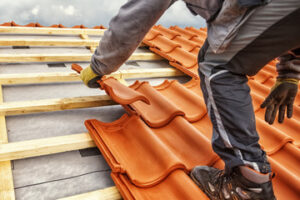Rosenberg Plumbing is a skill that is needed in all homes and businesses. Whether it is for unclogging toilets or installing new pipes, plumbers work on a variety of projects to keep water flowing properly.

They follow blueprints and building codes to install water supply lines, fixtures, and appliances. They also repair and inspect these systems.
When people think of plumbers, they often picture someone unclogging a drain or fixing a water heater. While these tasks are a large part of what plumbers do, they also design, build, and maintain piping systems that deliver water and remove waste in residential and commercial settings. These piping systems facilitate the distribution of water, gas, and waste in areas where people live and work, making them vital to human comfort and safety.
During the plumbing installation phase, plumbers follow blueprints and building codes to lay out pipes in new construction or renovation projects. They may start by removing existing fixtures or cutting into walls to locate and mark pipe routes. After determining the layout, they use tools like pliers, wrenches, and hammers to cut and join pipes. Plumbers then test for leaks, make sure all connections are tight, and install any necessary valves. They may also use plastic sheeting to protect floors and surfaces from damage.
Once the pipes are in place, plumbers can add fixtures like faucets, sinks, toilets, and garbage disposals. They might consult with a home’s designer or the homeowner to select decorative plumbing fixtures that fit with the overall aesthetic. These fixtures must be properly installed to avoid leaks, water flow restrictions, or water pressure changes.
Plumbers also inspect all drain and vent lines throughout a house to ensure they are clear of blockages or excessive slopes. This ensures that wastewater flows away from the house properly and prevents sewage backups, which can cause health and sanitation issues for household occupants.
Plumbers with a wide range of skills can be successful in this career, but the ability to identify and solve problems quickly is particularly important. Problems in plumbing can arise from many sources, including clogged drains, water leaks, and improperly functioning appliances. Finding and repairing these issues quickly can help reduce the risk of serious damage and costly repairs down the line. In addition to technical knowledge, plumbers must be able to communicate effectively with customers and other team members. They should be able to explain complex issues in simple terms and answer questions clearly.
Plumbing Repair
Plumbers repair and maintain plumbing fixtures and systems that deliver water, remove waste, and connect heating and cooling equipment in residential and commercial buildings. Their job duties may also include identifying and repairing leaks, inspecting piping for damage and ensuring that fixtures meet safety standards.
Leaking or broken plumbing fixtures, especially those near water sources like sinks, toilets and showers, can cause water damage, mold growth and higher utility bills. The plumber can repair or replace these fixtures and pipes to prevent further damage, saving the home or business owner money in the long run.
The plumbing professional will visually examine all of the visible piping in the home or business to check for leaks, cracks, damage and rust. They will also check the drainage system for signs of clogs or overflow, such as slow draining or gurgling noises. The plumber will also test water pressure to make sure it is adequate for household needs.
A thorough plumbing inspection can also identify potential hazards like gas leaks, overflowing sewage and vent pipes, and inadequate insulation for exposed piping. In addition, the plumber can recommend energy-efficient upgrades for piping and fixtures, helping the homeowner save money on utility bills.
Plumbing professionals must have good communication skills to relay their findings and explain complex technical procedures to customers. They must be able to work well under pressure and remain calm in emergency situations. They must also be willing to work a varied schedule, including evenings and weekends, to address plumbing emergencies in homes and businesses.
Many plumbers are self-employed or work for small companies that contract their services to larger businesses or construction firms. This gives them flexibility in their scheduling and allows them to choose which projects they want to take on. The career can be rewarding, but it can also be stressful as the plumber must adhere to strict health and safety standards when working with heavy machinery or around hazardous materials. The plumber must also keep up with industry practices and technologies to stay competitive in the field. Some plumbers specialize in certain areas, such as gas piping or medical gas systems.
Plumbing Inspection
Detecting small plumbing problems like leaks and clogs can help you save money in the long run by preventing costly repairs. A professional plumber conducts a comprehensive home plumbing inspection to check for these issues, which includes checking indoor and outdoor pipes, faucets, sinks, bathtubs, showers, toilets, water heaters and more. They will also assess the condition of the drainage system, ensuring it is free from blockages and slow drains. They may use specialized tools for inspecting hard-to-reach areas or inside of pipes. They will also test the water pressure to make sure it is within the recommended range.
Leaks and clogs are common in homes, but they can cause serious damage to the property if not repaired promptly. For example, a minor leak under a sink can lead to severe water damage and mold growth in just a few days. A professional plumber can identify and repair these issues before they get worse, saving you costly damages and potential health hazards.
Getting regular plumbing inspections can also increase the resale value of your home. A well-functioning plumbing system is a big selling point for buyers, as it can reduce energy costs and water waste, while maintaining a safe living environment. A plumber can inspect and evaluate your plumbing systems to ensure they are functioning properly, and provide recommendations on maintenance and upgrades.
A plumbing inspection report provides an in-depth overview of your home’s plumbing, including a list of all observed issues. It will also include suggestions for repairs or maintenance tasks and an estimate of the cost. It will also include preventive tips on how to keep your plumbing system running smoothly.
Performing plumbing inspections before purchasing a new home is an excellent idea, as it can help you avoid unexpected expenses and major problems. A detailed plumbing inspection can help you determine if the plumbing is in good condition and whether it meets the local codes. It can also protect you from buying a home with faulty plumbing, which could cost you thousands of dollars in damages and repair costs.
Plumbing Maintenance
Plumbing maintenance is an important part of keeping homes and businesses safe, clean and comfortable. Plumbers who specialize in this service regularly inspect and repair pipes, fixtures and other water and waste-related components to ensure they are working properly. This can prevent problems like leaks, clogs, and other issues that could lead to expensive repairs or replacements in the future.
Plumbers who provide maintenance services often work in commercial and industrial settings, as well as residential areas. These environments can include office buildings, retail spaces, hospitals, factories, and other large structures that serve multiple occupants and require complex plumbing systems to function effectively. Plumbers in these environments may also need to collaborate with other professionals, including construction teams and engineers, to ensure plumbing systems are integrated seamlessly into building projects and adhere to all relevant regulations and standards.
The majority of a plumber’s maintenance work is performed on existing plumbing systems in homes and businesses. This can include everything from repairing leaks and clogs to replacing worn out parts like water heaters and toilet flappers. In addition, plumbers who perform maintenance may need to repair or replace damaged appliances like dishwashers and washing machines. This work can be challenging because it requires removing and installing new fixtures, as well as making sure all existing connections are secure.
When conducting a maintenance inspection, a plumber will typically check all accessible water lines for signs of damage or leaks, including those that are hidden behind walls and under floors. They will also look at faucets, showerheads, toilets and other fixtures for signs of wear or damage. The plumber may also test water pressure and drainage flow to ensure adequate performance.
Many homeowners try to do their own plumbing maintenance, but this can be risky and ineffective if not done correctly. It is much better to leave it to a professional plumber who has the training and tools to diagnose and fix problems quickly and efficiently. Plumbers can also advise home and business owners on the best maintenance practices to keep their plumbing running smoothly for years to come.








